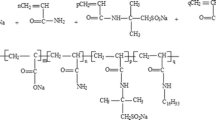Abstract
In this paper, a bifunctional associative polymer with twin tail and long chain was synthesized. Its structure was confirmed by FT-IR and NMR. The goal is to find the solution of front-end drag reduction and tail-end sand carrying. Fluorescence spectrum, laser particle size, and scanning electron microscope (SEM) were used to analyze the microstructure of the polymer. Fracturing fluid friction meter was used to evaluate the drag reduction rate (DR) as a function of concentration, temperature, and flow. It shows a connection between the number, morphology, and concentration of hydrophobic microregions generated by the association polymer. A hydrophobic microregion of the tail supplies the tail end with increased viscosity and sand carrying at low concentrations. The intermolecular interactions get stronger with increasing concentrations at high concentrations. A space grid structure is constructed after a specified association concentration reaching. High shear will break some molecular chains at this time due to the weak bonding effect, limiting the drag reduction effect. The results show that drag reduction rate (DR) can reach 72% with the flow rate increasing from 15 to 40 L·min−1 when the concentration reaches 2000 mg/L and the temperature is 30 ℃.
Graphical Abstract












Similar content being viewed by others
References
Wang H, Liao X, Ding H (2015) Monitoring and evaluating the volume fracturing effect of horizontal well. J Nat Gas Sci Eng. https://doi.org/10.1016/j.jngse.2015.01.005
Barati R, Liang J (2014) A review of fracturing fluid systems used for hydraulic fracturing of oil and gas wells. J Appl Polym Sci. https://doi.org/10.1002/app.40735
Bo Y, Jinzhou Z, Jincheng M et al (2019) Review of friction reducers used in slickwater fracturing fluids for shale gas reservoirs. J Nat Gas Sci Eng. https://doi.org/10.1016/j.jngse.2018.12.016
Sanders M, Felling K, Thomson S et al (2016) Dry polyacrylamide friction reducer: not just for slick water. The Woodlands, Texas, USA. SPE
Shen L J, Vigderman L, Heller D et al (2018) Can friction reducers transport sand during fracturing treatment. Proceedings of the 6th Unconventional Resources Technology Conference. Houston, Texas, USA. Tulsa, OK, USA: American Association of Petroleum Geologists
Thomas M, Pidgeon N, Evensen D et al (2017) Public perceptions of hydraulic fracturing for shale gas and oil in the United States and Canada. Wiley Interdiscip Rev Clim Change. https://doi.org/10.1002/wcc.450
Zhang F, Shen Y, Ken T et al (2016) Synthesis and properties of polyacrylamide drag reducer for fracturing fluid. Chem Eng J. https://doi.org/10.16085/j.issn.1000-6613.2016.11.038
Kamel A, Shah SN (2009) Effects of salinity and temperature on drag reduction characteristics of polymers in straight circular pipes. J Petrol Sci Eng. https://doi.org/10.1016/j.petrol.2009.02.004
Xing L, Ke Y, Hu X et al (2019) Preparation and properties of amphoteric polyacrylamide/modified montmorillonite nanocomposites and its drag reduction performance. Colloids Surf A Physicochem Eng Asp. https://doi.org/10.1016/j.colsurfa.2019.04.078
Li Y, Ren Q (2018) Synthesis, characterization, and solution properties of a surface-active hydrophobically associating polymer. J Appl Polym Sci. https://doi.org/10.1002/app.46569
Wu G, Jiang X, Yu L et al (2016) Hydrophobically associating polyacrylamide derivatives with double bond for enhanced solution properties. Polym Eng Sci. https://doi.org/10.1002/pen.24337
Jincheng M, Hongzhong T, Bo Y et al (2018) Novel Hydrophobic Associating Polymer with Good Salt Tolerance. Polymers. https://doi.org/10.3390/polym10080849
Asidin MA, Suali E, Jusnukin T (2019) Review on the applications and developments of drag reducing polymer in turbulent pipe flow. Chinese J Chem Eng. https://doi.org/10.1016/j.cjche
Mohammadtabar M, Sanders RS, Ghaemi S et al (2020) Viscoelastic properties of flexible and rigid polymers for turbulent drag reduction. J Nonnewton Fluid Mech. https://doi.org/10.1016/j.jnnfm.2020.104347
Guoyan M, Xiaorui L, Xiaorong W et al (2019) Preparation, rheological and drag reduction properties of hydrophobically associating polyacrylamide polymer. J Dispers Sci Technol. https://doi.org/10.1080/01932691.2018.1461637
Wang L, Wang D, Shen Y et al (2016) Study on properties of hydrophobic associating polymer as drag reduction agent for fracturing fluid. J Polym Res. https://doi.org/10.1007/s10965-016-1129-8
Zhi-yu L, Fu-jian Z, Hong-yan Q (2017) Impact of the microstructure of polymer drag reducer on slick-water fracturing. Geofluids. https://doi.org/10.1155/2017/9080325
Quan Z, Jincheng M, Yuemin L et al (2022) Evaluation of temperature resistance of non-chemical crosslinked double-tailed hydrophobically associating polymer fracturing fluid. React Funct Polym. https://doi.org/10.1016/j.reactfunctpolym.2022.105268
Zhu Z, Kang W, Sarsenbekuly B et al (2016) Preparation and solution performance for the amphiphilic polymers with different hydrophobic groups. J Appl Polym Sci. https://doi.org/10.1002/app.44744
Haoyi W, Meiqin L, Zhaoxia D et al (2020) Study on the association behavior of synthesized hydrophobically associating polymer microspheres. Colloids Surf A Physicochem Eng Asp. https://doi.org/10.1016/j.colsurfa.2020.124829
Choueiri GH, Lopez JM, Hof B (2018) Exceeding the asymptotic limit of polymer drag reduction. Phys Rev Lett. https://doi.org/10.1103/physrevlett.120.124501
Funding
This work was supported by the National Natural Science Foundation of China (51604052, 51774062), Natural Science Foundation of Chongqing, China (cstc2019jcyj-msxmX0064), Scientific and Technological Key Research Program of Chongqing Municipal Education Commission (KJZD-K202201504).
Author information
Authors and Affiliations
Corresponding author
Ethics declarations
Conflict of interest
The authors declare no competing interests.
Additional information
Publisher's Note
Springer Nature remains neutral with regard to jurisdictional claims in published maps and institutional affiliations.
Rights and permissions
Springer Nature or its licensor (e.g. a society or other partner) holds exclusive rights to this article under a publishing agreement with the author(s) or other rightsholder(s); author self-archiving of the accepted manuscript version of this article is solely governed by the terms of such publishing agreement and applicable law.
About this article
Cite this article
Zhou, C., Zhou, M., Sun, Y. et al. Preparation and analysis of microstructural drag reduction mechanism of bifunctional associative polymers with twin tail and long-chain structure for fracturing. Colloid Polym Sci 301, 63–72 (2023). https://doi.org/10.1007/s00396-022-05044-3
Received:
Revised:
Accepted:
Published:
Issue Date:
DOI: https://doi.org/10.1007/s00396-022-05044-3




